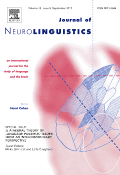
JOURNAL OF NEUROLINGUISTICS
Scope & Guideline
Charting New Territories in Neurolinguistic Research
Introduction
Aims and Scopes
- Cognitive Mechanisms in Language Processing:
The journal explores how cognitive processes impact language production and comprehension, delving into mechanisms like attention, memory, and executive function across different populations. - Neurological Impairments and Language Disorders:
Research published in the journal frequently addresses language disorders resulting from neurological conditions such as aphasia, Alzheimer's disease, and Parkinson's disease, contributing valuable insights into diagnosis and treatment. - Cross-Linguistic and Bilingual Studies:
A significant emphasis is placed on bilingualism and the effects of language switching, providing insights into how language proficiency and experience shape cognitive control and processing. - Neuroimaging and Electrophysiological Approaches:
The journal prominently features studies utilizing neuroimaging techniques (fMRI, EEG) and electrophysiological measures (ERPs) to investigate the neural correlates of language processing, enhancing understanding of the brain's role in language. - Integration of Linguistic and Motor Functions:
Research often investigates the relationship between language and motor functions, examining how gestures and motor control contribute to language production and comprehension.
Trending and Emerging
- Neurophysiological Correlates of Language Production:
There is an increasing focus on understanding the neurophysiological mechanisms underlying language production, particularly through studies utilizing event-related potentials (ERPs) and fMRI to track neural responses during language tasks. - Language and Cognitive Aging:
Research addressing the effects of aging on language processing, particularly in populations with mild cognitive impairment and dementia, is on the rise, emphasizing the importance of language as a cognitive marker in aging. - Impact of Neuromodulation Techniques:
Emerging studies are investigating the effects of neuromodulation techniques (e.g., tDCS, vagus nerve stimulation) on language processing and rehabilitation, indicating a trend towards therapeutic applications in neurolinguistics. - Interaction of Language and Emotion:
The interplay between language processing and emotional context is gaining attention, with studies exploring how emotional factors influence language comprehension and production. - Multimodal Language Processing:
An increasing number of studies are exploring the integration of verbal and non-verbal modalities (e.g., gestures, music) in language processing, highlighting the importance of a holistic understanding of communication.
Declining or Waning
- Traditional Linguistic Approaches:
There appears to be a waning interest in purely traditional linguistic frameworks that do not integrate neurocognitive perspectives, as more researchers favor interdisciplinary approaches that incorporate neuroscience. - Static Models of Language Processing:
Research focusing on static models of language processing is becoming less prevalent, with a noticeable shift toward dynamic and interactive models that account for real-time language use and cognitive flexibility. - Generalized Studies on Language Acquisition:
While language acquisition remains a core topic, generalized studies lacking specificity regarding bilingual contexts or neurological conditions have decreased, signaling a trend toward more nuanced and context-specific research.
Similar Journals
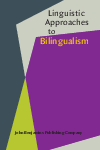
Linguistic Approaches to Bilingualism
Elevating the Discourse on Bilingual Language UseLinguistic Approaches to Bilingualism, published by John Benjamins Publishing Co, stands as a leading journal in the field of linguistics, particularly recognizing the complexities and nuances of bilingualism. Established in 2011, this journal has quickly risen to prominence, achieving a Q1 ranking in Linguistics and Language as of 2023, underscoring its impact and relevance within the academic community. With an impressive Scopus ranking that places it in the top 12% and 13% in the Arts and Humanities and Social Sciences categories respectively, it is an essential resource for researchers, professionals, and students alike. The journal aims to publish innovative and interdisciplinary research that contributes to a deeper understanding of bilingual language processing, acquisition, and usage, making it invaluable for those studying the interplay of language and cognition. Although it does not currently offer open access options, its rigorous peer-review process ensures that each publication meets the highest academic standards, fostering insightful discussions and advancements within the field.
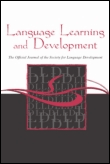
Language Learning and Development
Exploring innovative methodologies for effective language learning.Language Learning and Development, published by Routledge Journals, Taylor & Francis Ltd, is a premier academic journal that stands at the forefront of research in the fields of education and linguistics. With a robust ISSN of 1547-5441 and E-ISSN 1547-3341, this journal not only boasts an impressive Q1 classification in both Education and Linguistics for 2023 but also ranks favorably in Scopus metrics, highlighting its significance in advancing scholarship. Situated in the United Kingdom, it focuses on the intersection of language acquisition, cognitive development, and pedagogical practices, making it an essential resource for researchers, educators, and students alike. Given its commitment to publishing rigorous research articles, Language Learning and Development aims to foster dialogue and explore innovative methodologies in language learning, providing an invaluable platform for contemporary issues and advancements in this dynamic field.
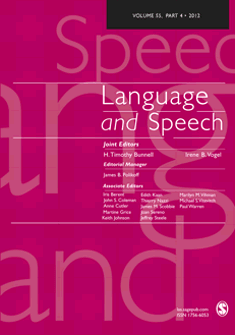
LANGUAGE AND SPEECH
Fostering Innovation in Linguistic and Sociological StudiesLANGUAGE AND SPEECH, published by SAGE PUBLICATIONS LTD, is a premier journal that serves the multifaceted realms of linguistics, speech science, and sociology. With a robust history of scholarly contribution since 1958 and an anticipated continuation through to 2024, the journal is recognized for its high-impact research, boasting a commendable impact factor and achieving Q1 ranking in both Linguistics and Sociology as well as Q2 in Medicine and Speech and Hearing categories as of 2023. The journal, available in both print and online formats with ISSN 0023-8309 and E-ISSN 1756-6053, provides a vital platform for interdisciplinary discourse among researchers, professionals, and students alike. Its rigorous review process and quality publications place it at the forefront of academic inquiry, offering critical insights that advance the understanding of language and its implications in various contexts. As a key resource in the field, LANGUAGE AND SPEECH continues to foster innovation and knowledge dissemination, making it an essential addition to the libraries of those committed to exploring the depths of communication sciences.
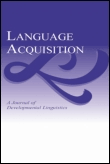
Language Acquisition
Fostering interdisciplinary insights into language development.Language Acquisition, published by ROUTLEDGE JOURNALS, TAYLOR & FRANCIS LTD, is a leading academic journal dedicated to the interdisciplinary study of language development and acquisition. With an ISSN of 1048-9223 and E-ISSN 1532-7817, this peer-reviewed journal caters to professionals, researchers, and graduate students in the fields of linguistics and educational psychology. The journal boasts an impressive 2023 Scopus ranking of Q1 in Linguistics and Language and Q2 in Education, reflecting its high impact and relevance within academic circles. Notably, it is indexed among the top 15% of journals in Language and Linguistics, showcasing its significance in contributing knowledge to these vibrant fields. Although currently not open access, Language Acquisition makes a profound impact on understanding how individuals acquire language, facilitating discussions on pedagogical strategies, cognitive development, and sociolinguistic factors. The journal's historical and ongoing contributions since its inception in 1990 reinforce its position as a vital resource for advancing research and theory related to language acquisition.
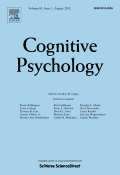
COGNITIVE PSYCHOLOGY
Advancing Insights in Cognitive ScienceCOGNITIVE PSYCHOLOGY is a premier academic journal published by Academic Press Inc. Elsevier Science, specializing in the dynamic and evolving field of cognitive psychology. With a significant history spanning from 1970 to 2024, this journal has established itself as a critical resource for researchers and professionals alike, boasting a distinguished ranking in the Q1 category across multiple disciplines, including Experimental and Cognitive Psychology, Neuropsychology, and Artificial Intelligence. Its impact factor, reflective of its influence and reputation within the academic community, positions COGNITIVE PSYCHOLOGY as an essential platform for disseminating cutting-edge research and theoretical advancements. Although it is not open access, subscribers gain exclusive insights into the latest findings that drive the field forward. The journal's commitment to fostering innovative research makes it an indispensable tool for those dedicated to understanding the complexities of human cognition.
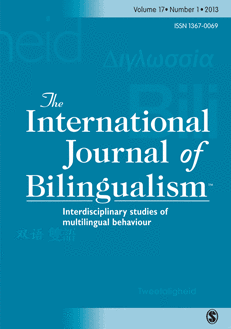
International Journal of Bilingualism
Bridging cultures through bilingual studies.The International Journal of Bilingualism, published by SAGE Publications Ltd, stands as a distinguished forum within the fields of Education and Linguistics, boasting an impressive Q1 ranking in both categories as of 2023. Since its inception in 1997, this journal has been at the forefront of bilingualism research, contributing to a deeper understanding of language use, acquisition, and policy in multilingual contexts. With its ISSN of 1367-0069 and E-ISSN 1756-6878, the journal serves a global audience of researchers, educators, and students dedicated to advancing knowledge in bilingualism. The journal is recognized for its rigorous peer-review process and high impact, indicated by its Scopus rankings, which place it in the top percentile among its peers. Although currently not offered as open access, the International Journal of Bilingualism remains an essential resource for cutting-edge research and dialogue in the dynamic field of bilingual studies, thereby significantly impacting educational practices and language policy decisions worldwide.
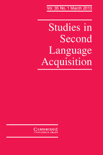
STUDIES IN SECOND LANGUAGE ACQUISITION
Navigating the evolving landscape of second language studies.STUDIES IN SECOND LANGUAGE ACQUISITION, published by Cambridge University Press, is a premier journal dedicated to advancing the field of second language acquisition. With an ISSN of 0272-2631 and an E-ISSN of 1470-1545, this journal has carved its niche as a leading resource for scholars and practitioners alike since 1978. Recognized in Q1 quartiles across both Education and Linguistics and Language, and ranked within the top 2% in its fields according to Scopus, it provides a platform for cutting-edge research that addresses the complexities of language learning and teaching. Although it does not currently offer open access, the journal remains widely accessible through institutional subscriptions, ensuring that groundbreaking research reaches a global audience. With a focus on empirical studies, theoretical discussions, and innovative methodologies, STUDIES IN SECOND LANGUAGE ACQUISITION is essential for those seeking to deepen their understanding of language education, making it a must-read for researchers, educators, and students committed to the evolving landscape of language acquisition.
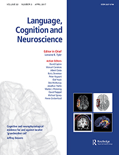
Language Cognition and Neuroscience
Exploring the Neural Pathways of Language and ThoughtLanguage Cognition and Neuroscience is a premier peer-reviewed journal published by ROUTLEDGE JOURNALS, TAYLOR & FRANCIS LTD, focusing on the intersection of linguistics, cognitive psychology, and neuroscience. Since its inception in 2013, this journal has established itself as a vital resource for researchers and scholars, contributing significantly to the understanding of how language is processed and represented in the brain. With its impressive rankings in various categories—Q1 in Linguistics and Language, Q2 in Cognitive Neuroscience, and Experimental and Cognitive Psychology—it caters to a diverse and interdisciplinary audience. The journal is accessible to readers worldwide, effectively communicating cutting-edge research and innovative methodologies in the field. Open Access options enable broader disseminations of knowledge, ensuring that significant findings reach both academic and practical applications. With a commitment to high-quality research, Language Cognition and Neuroscience continues to be an influential platform for advancing theories and practices within cognitive science and language studies.

Annual Review of Linguistics
Unveiling Trends and Theories in LinguisticsAnnual Review of Linguistics is a premier scholarly journal dedicated to advancing the field of linguistics through comprehensive and insightful reviews of current research and emerging trends. Published by ANNUAL REVIEWS, this journal is recognized for its high impact, evidenced by its Q1 ranking in the Linguistics and Language category and exceptional placements in the Scopus Ranks, positioning it in the top 2% of its field. Since its inception in 2015, the journal has served as a vital resource for researchers, professionals, and students seeking to deepen their understanding of language theories, acquisition, processing, and sociolinguistics. With no Open Access currently available, the Annual Review of Linguistics is esteemed for its rigorous peer-reviewed articles that synthesize a wealth of knowledge, making it an indispensable tool for advancing research and dialogue within the linguistic community.
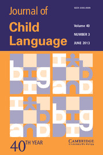
JOURNAL OF CHILD LANGUAGE
Advancing Insights into Child Language AcquisitionJOURNAL OF CHILD LANGUAGE, published by Cambridge University Press, is a premier scholarly journal dedicated to the exploration and examination of language development in children. Since its inception in 1974, the journal has become an authoritative source in the fields of Developmental and Educational Psychology, Experimental and Cognitive Psychology, and Linguistics, boasting significant impact as evidenced by its ranking in the top quartiles across these domains. With an impressive impact factor and a commitment to advancing research, the journal serves as a vital platform for researchers, educators, and practitioners interested in the intricacies of language acquisition and cognitive development in children. The 2023 Category Quartiles place it in Q1 for Linguistics and Language, further establishing its excellence. Fostering a rich intellectual community, the journal invites contributions that advance our understanding of child language, promising a broad readership in both the social sciences and humanities.